Brilliant report on the late Professor Yuri Grigoriev packed full of historic information and research. His work will continue to alert the world to dangers associated with microwave radiation. He said:
“Man has conquered the Black Plague,” he would say, “but he has created new problems —EMF pollution.” He called the proliferation of RF sources “out of control.”
THE COLD WAR OF ELECTRO-MAGNETIC RADIATION
Announcing the English translation of Yuri Grigoriev’s book, 5G Cellular Standards available as a free download (link at foot of this article)
Frances Leader
Yuri Grigoriev, a Russian biophysicist and a singular figure in the world of electromagnetic health and safety over the last 50 years, died in Moscow on April 6 2021 at the age of 95.

Yuri Grigoriev (1925-2021) with his Soviet State Prize Medal
“We have lost a ‘scientific grandfather’,” Oleg Grigoriev told Microwave News. “Yuri supported scientists and pushed them to do research. He was greatly respected by all his colleagues, myself included.” Yuri was one of Oleg’s mentors —they are not related— encouraging him to finish his doctoral dissertation. Oleg later served as the director of the Centre for Electromagnetic Safety in Moscow for 20 years, until 2015.
Yuri was a man with a “big soul and warm heart,” Oleg Grigoriev wrote on Twitter.
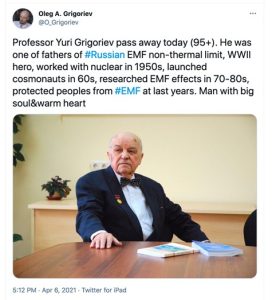
In contrast to many of his counterparts in the West, Yuri Grigoriev promoted the idea that microwave biology is more complex than simple tissue heating. His views were based, in part, on his own research showing the importance of modulation characteristics.
He is also known for his steadfast support for the Soviet and later Russian health standards, which are designed to protect against long-term effects and are much stricter than those adopted in most other countries. ANSI, ICNIRP and the IEEE have never acknowledged the existence of chronic effects, setting their exposure limits at levels that are up to a thousand times higher.
The contrasting view of what the standards should be has been a source of East-West tension since the Cold War began. It continues today.
“Professor Grigoriev was one of the first scientists to draw conclusions on the role of modulation in RF biological effects and on the increased sensitivity of children to RF,” said Igor Belyaev, the head of the Department of Radiobiology at the Biomedical Research Centre of the Slovak Academy of Sciences in Bratislava.1
Grigoriev was popular and had many friends on both sides of the aisle —whether or not they shared a common outlook. “His great heart, generosity and friendly smile will be sorely missed,” Michael Repacholi, the founder and former chairman of ICNIRP, told me.
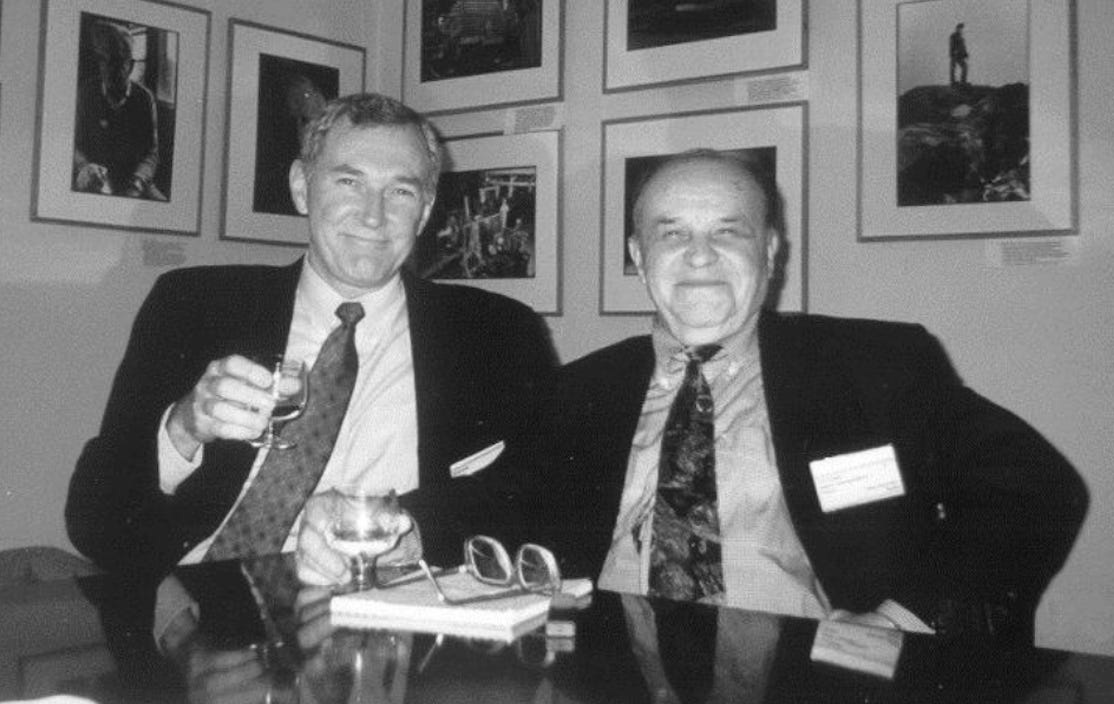
With Michael Repacholi in Moscow in 1999
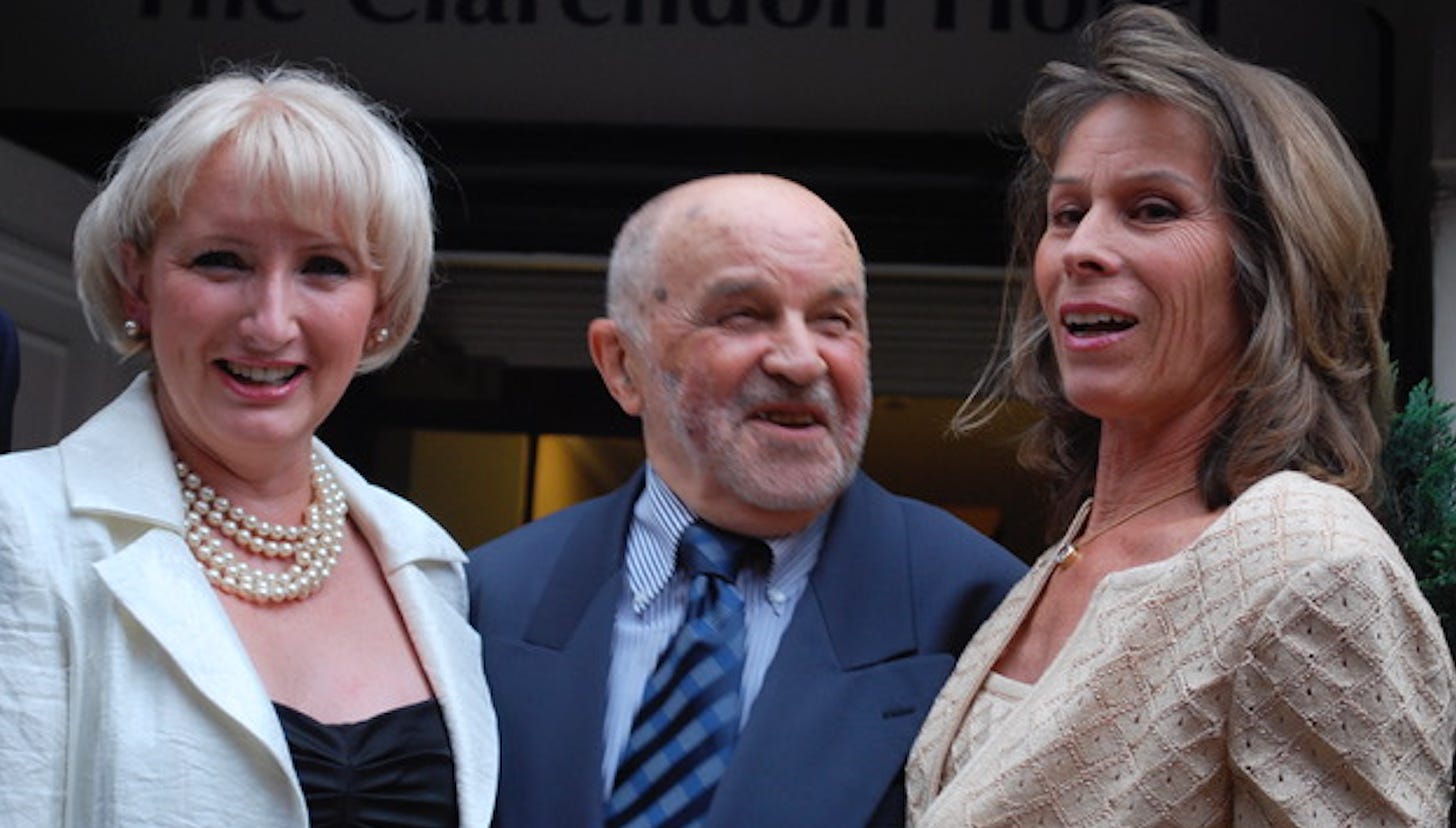
With RRT’s Eileen O’Connor and Cindy Sage (co-editor of BioInitiative Report) in London in 2008
“Yuri was a real hero,” said Eileen O’Connor of the Radiation Research Trust, a U.K. citizens’ advocacy group. “He was a great scientist with strong moral and ethical principles.”
“It is so sad to know that my old dear friend Yuri passed away,” wrote C.K. Chou, formerly with Motorola, in an email message to colleagues. “I already miss him.” Chou first met Grigoriev in Seattle in the early 1980s, when he was a graduate student in Bill Guy’s lab at the University of Washington. Chou has played a leading role in the writing of RF exposure standards for decades, often disagreeing with Grigoriev on how they should be set.
A Life of Ups and Downs
Grigoriev was born in Ukraine in 1925; his family moved to Moscow when he was seven years old. He gained entry to medical school in Leningrad (now Saint Petersburg) in 1944, but only after serving at a field hospital on the front lines in WWII —where he contracted typhoid fever.
The highs and lows would continue. But whatever the setback, Grigoriev regrouped and moved forward. He was a survivor.
Grigoriev became a radiation biologist, earning a doctorate in 1953. One of his first assignments was at the Institute of Biophysics in Moscow, investigating the effects of ionizing radiation in medical applications (for instance, in radiotherapy). A later project was on how to protect cosmonauts from the high-energy cosmic rays encountered in space travel.
He did well. He won the Order of Lenin in 1976 and the prestigious State Prize in 1978. His success offered him the coveted opportunity to travel outside the Soviet Union. Grigoriev took good advantage; he went to the U.S. often, and he got around —to Berkeley, the Houston space centre, even the White House.
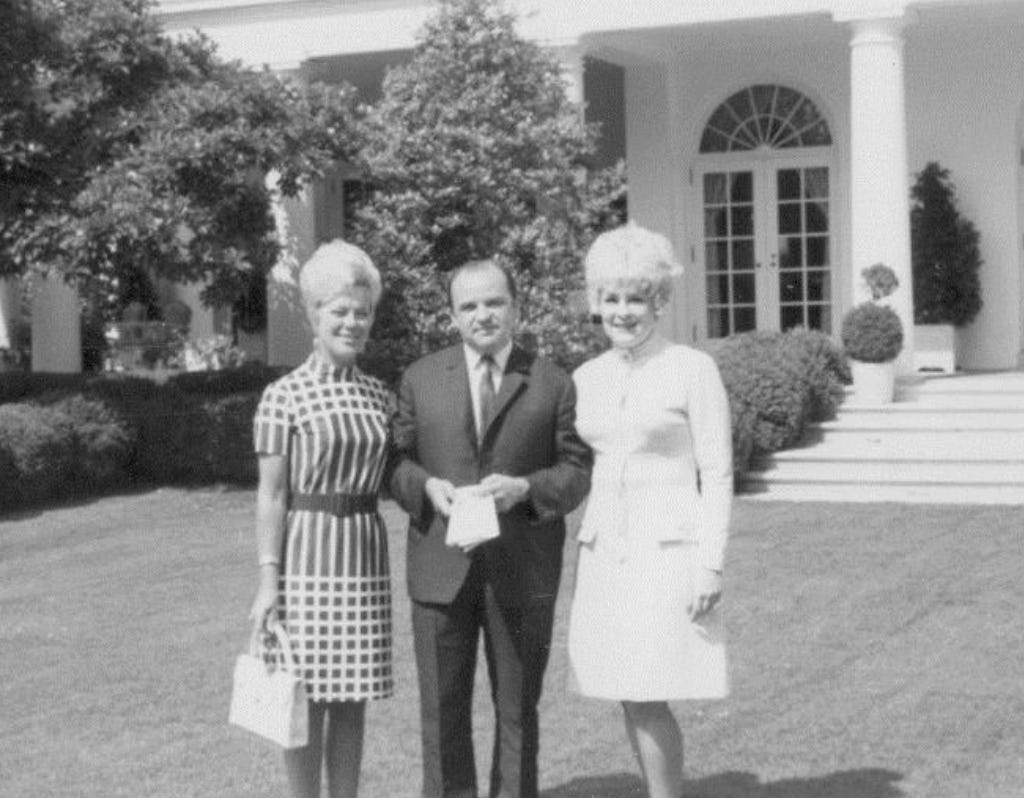
At the White House in 1971
Grigoriev’s expertise on ionizing radiation would later take him to Chernobyl a few weeks after the reactor meltdown in 1986 to help care for the workers. “We landed in Kiev, got into a helicopter and flew to hell, in the truest sense of the word,” he later recalled.
In April 1977, Grigoriev was appointed the head of a new research lab at the Institute of Biophysics in Moscow for the study of the biological effects of low- and high-frequency radiation. At the same time, he became the deputy director of the entire Institute.
But then, a decade later, he fell out of favour with the KGB and was forced out of the radiation program and the Institute. Nevertheless, Grigoriev managed to hang on. He stayed active and continued to do research, confer over standards and travel widely.
In 1997, five years after Repacholi set up ICNIRP, Grigoriev founded a Russian version, albeit with a different structure but with a very similar name: the Russian National Committee on Non-Ionizing Radiation Protection (RNCNIRP). He was the first chairman.
His life took another turn in 2014. Grigoriev, now 88 years old, was asked to step down from the RNCNIRP chair. Some believed he had overstepped, and it was time for change. Oleg Grigoriev, the head of the non-ionizing laboratory at the Institute of Biophysics, became the new chairman.
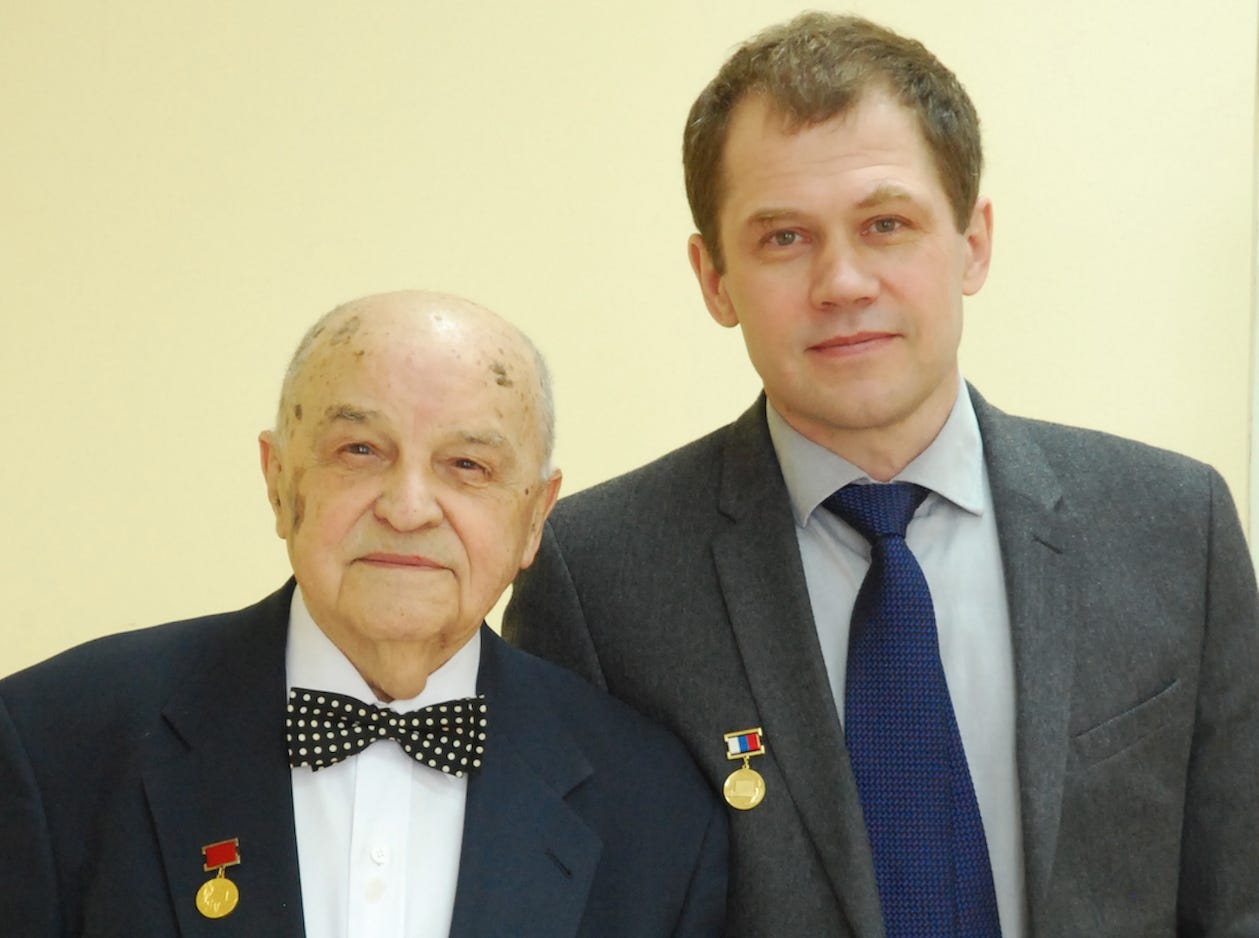
With Oleg Grigoriev in Moscow 2015
Yuri Grigoriev remained busy to the end. But his reach was now limited, and age was forcing him to slow down. He had lost his platform; still, he kept in touch with campaigners around the world. They welcomed his non-thermal outlook and his advocacy of precaution. Several told me that they started worrying about him at the end of last year when his Christmas card never arrived.
An Accidental Discovery
Grigoriev’s segue from the ionizing to the non-ionizing side of the electromagnetic (EM) spectrum happened by chance. In the 1950s, he was a member of a research group studying the effects of X-rays on the electrical activity in the brains of rabbits. To their surprise, they observed some dramatic changes in the EEGs of the controls —that is, when the X-ray source was turned off. They became convinced that a nearby transformer was responsible and that EMFs could have a “direct action” on the brain. These findings were reported in the Bulletin of Experimental Biology and Medicine in 1960. It was the first of Grigoriev’s many papers on EM radiation.
Allan Frey, an American biophysicist who has made a number of original contributions to EM science —most notably for discovering microwave hearing, often called the Frey effect— met Grigoriev during a month-long trip to the Soviet Union in the early 1970s.
The Soviet Academy of Sciences had invited Frey to give a series of seminars. One stop on the itinerary was the Academy’s Institute of Biophysics in Pushchino, a so-called science city located about 60 miles south of Moscow. Grigoriev came down to meet Frey and hear what he had to say.
At a formal dinner that night, Frey was seated between Grigoriev and Inal Akoev, the institute’s deputy director. “Grigoriev served as my host and was very friendly,” Frey told me recently. “He was very interested in what I was finding about the importance of carrier frequency and modulation.”
Frey, Grigoriev and Akoev shared a common interest in how modulating a carrier wave can change its biological impact. Modulation is a way to alter the otherwise simple sine waves of the carrier signal to accomplish a given goal. Amplitude modulation, for example, gives you AM radio. You tune in to a specific frequency for a favourite station, but it’s the modulation of that carrier frequency which brings the words and music.
The Frey effect is, after all, about modulation —pulse modulation, as used in radar. People can hear microwaves only when they are pulsed. As Frey explained when he presented microwave hearing as a “new phenomenon” in 1962, whether you hear a “buzz, clicking, hiss or knocking” sound depends on the pulse modulation.
A.H. Frey, Journal of Applied Physiology, 1962
Grigoriev and Frey stayed in touch for years afterwards.
At the time, Pushchino was a major centre for research on EM bioeffects. “I was told I was the first Westerner allowed into Pushchino,” Frey recalled. “Some U.S. agencies were most interested in talking with me about the place when I got back.”
Modulations — Studied and Ignored
Y.G. Grigoriev, “Basic Materials for Electromagnetic Field Standards,” November 2003, p.67
At about the same time that Frey was visiting Pushchino, Ross Adey and Suzanne Bawin at the UCLA Brain Research Institute in Los Angeles were seeing a similar “window,” as they called it, in how the radiation affected the movement of calcium ions through cell membranes. They found a maximum effect with 16 Hz AM (see below). This work was later replicated by Carl Blackman at an EPA lab in North Carolina.
S. Bawin, L. Kaczmarek and W.R. Adey, Annals of the NYAS, 1975
In a major review of the literature in 1981 —it’s been cited more than 1,000 times in subsequent papers— Adey highlighted the importance of modulation:
“[T]here is unequivocal experimental evidence that fields from [10 Hz – 450 MHz] interact directly with brain tissue. A striking feature of some of these observed interactions with weak RF fields is their relationship to modulation in the ELF range and not to the radio carrier frequency.”
This finding has largely been discounted by those setting exposure standards in the U.S and by ICNIRP. [2] Even if it’s a true biological effect, the rationale goes, it doesn’t necessarily mean there’s a health effect. The subtext is that if modulations were to be taken into account it would imply the existence of non-thermal effects, and that would be unacceptable.
Grigoriev’s work with frog hearts fared no better. Even worse, it was ignored. As he lamented in a 2003 review, “Unfortunately, the results of the examinations conducted in Russia on a biological effect of modulated EMF till now are not known in the West and in the USA.” [3]
Still, Grigoriev didn’t let up the pressure. In a joint 2007 paper, he and Igor Belyaev made a plea:
“The findings regarding the role of modulation are extremely important to consider in non-thermal microwave exposures and should be more thoroughly studied using those specific types of modulations that are used in mobile communications.”
Advocate for Strong Exposure Limits
The disconnect between the two sets of standards has been a source of U.S.-USSR/Russian discord for 50 years.
As Don McRee of the National Institute of Environmental Health Sciences (NIEHS) wrote in 1979: The “large volume of Soviet and East European research has been a driving force in the United States in producing concern over the biological effects of microwave radiation.”
The U.S. military was ready to do whatever was necessary to make sure that a Russian-style standard was never adopted in the West. If that were to happen, planners worried, it would limit the use of many military systems, most especially radars, as well as leave the services liable to compensation claims from injured workers.
The late Herbert Pollack, a medical doctor who worked for the state department on microwave health issues and who was heavily involved in the Moscow embassy affair, explained what was at stake at a Senate hearing [p.279] in 1977:
“[I]t can be said that the Soviet military are not bound by their current safety standards, but the U.S. military are bound by ours. This is important to bear in mind if new standards are promulgated. It is difficult to imagine that the Soviet military could function effectively under the restrictive natures of their current limits.”
Pollack did not say so directly, but the implication was evident: If a Soviet-style standard [4] were adopted in the U.S., [5] the military would be unable to function effectively.
The so-called flaws of the Soviet standard became a pervasive American meme. Here’s how NIEHS’ McRee put it:
“First, the [Soviet] maximum permissible exposure level is set at the value where no biological effects occur. No differentiation between effects and hazards is made in setting their standards.”
The message was that not only was the standard unnecessarily strict, but the research it was based on was so sloppy and ill-defined that it was next to impossible to repeat. As McRee wrote:
“Most of their papers do not give details concerning the experimental design and exposure techniques. Because of these unknowns, a strong motivation to ignore much of the Soviet and Eastern European results exists in the U.S.”
A joint U.S.–Soviet microwave program was set up in 1975 to see if the scientists could resolve their differences. McRee led the U.S. delegation. They didn’t make much progress. Part of the reason was the scarcity of money for research in the U.S.
But there was another factor too: One of the first American experiments to see if a Russian experiment could be repeated —carried out by Richard Lovely at the University of Washington in Seattle— supported the Soviet findings. [6] After that, the U.S. replication efforts lost their urgency and faded away.
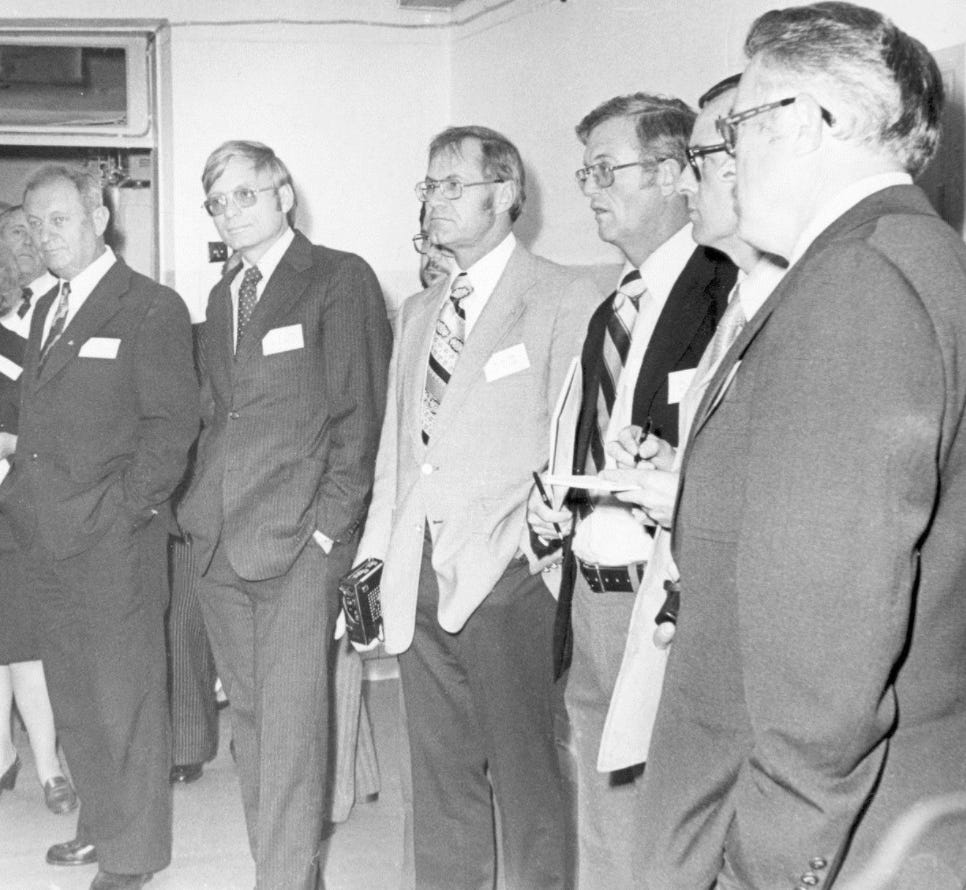
U.S. and Soviet scientists meet in Kiev in 1977; McRee is third from right; full cast below [7]
In an email exchange for this article, I asked Frey about attitudes to the Soviet research in the U.S. at that time. “The Soviets did some fine work,” he replied. “I saw a lot of it in the Soviet Union. It was grossly misreported and misrepresented in the U.S.”
Soviet Microwave Standard Revised in 1984
Nothing much changed for years —until cell phones came on the scene. Then, a new effort was made to bridge the gap between the East and West. It was called harmonisation and became the mission of Michael Repacholi at the WHO International EMF Project in Geneva with the financial support of cell phone manufacturers and network operators.
Harmonisation meetings were organised. The first was held in Moscow in 1998, another the following year. Grigoriev could see no progress. “So far we have entirely different approaches to harmonisation,” he said at the 1999 conference (see MWN, N/D99).
At the next meeting, in 2002, Grigoriev had not budged.
“Currently, our knowledge on the health effect mechanism of RF EMF of low-intensity confirm the justified strict-acting standards imposed in Russia,” he stated.
At the time of the 2002 meeting, Repacholi went over both Yuri and Oleg Grigoriev’s heads. He made the case for harmonisation in a meeting with the First Deputy Minister of Health, Gennady Onischenko (see below). Nothing came of this either.
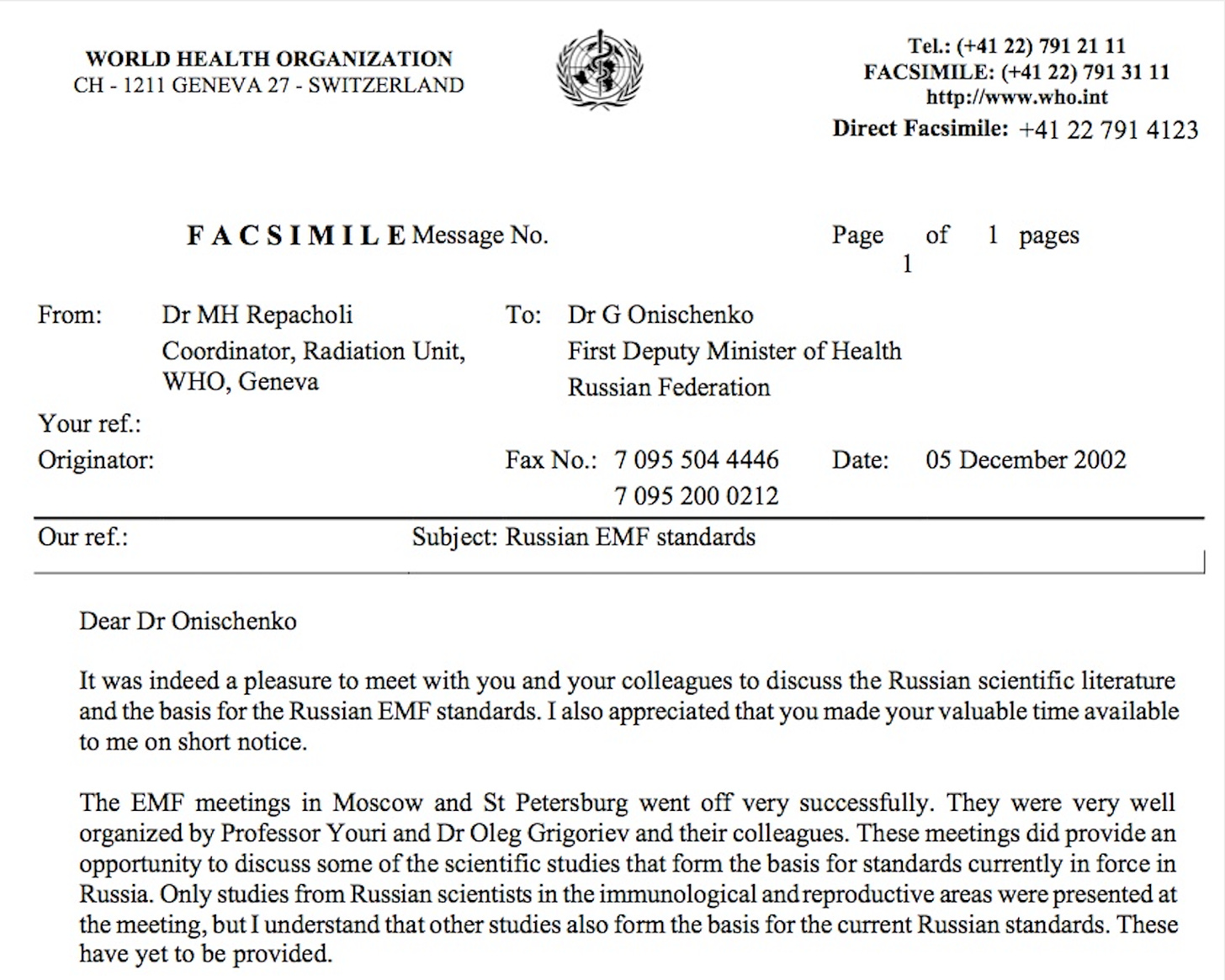
Excerpt of fax from WHO’s M. epacholi to G. Onischenko, Dec 5, 2002
Repacholi didn’t give up. With the support of the GSMA, the association of cell phone network operators, he organized another meeting in 2012. Once again, little progress was made.
The chasm between the Russian and American/ICNIRP limits remains today.
A Last Hurrah
During his last years, Grigoriev became more and more of an activist, calling for the application of the precautionary principle, especially when children could be exposed to electromagnetic radiation.
“Man has conquered the Black Plague,” he would say, “but he has created new problems —EMF pollution.” He called the proliferation of RF sources “out of control.”
Before he died, Grigoriev finished a book detailing the challenges posed by the introduction of 5G networks, written with co-author A.S. Samoylov, a specialist in sports medicine.
Leonid Ilyin, the former director of the Institute of Biophysics in Moscow, set out their concerns in a preface to the book:
“The entire world’s population will be trapped for life in the electromagnetic grid of millimetre waves and no one will be able to avoid their impact.”
Ilyin, now 94 years old, is a “Hero of Socialist Labour,” one of the country’s highest honours.
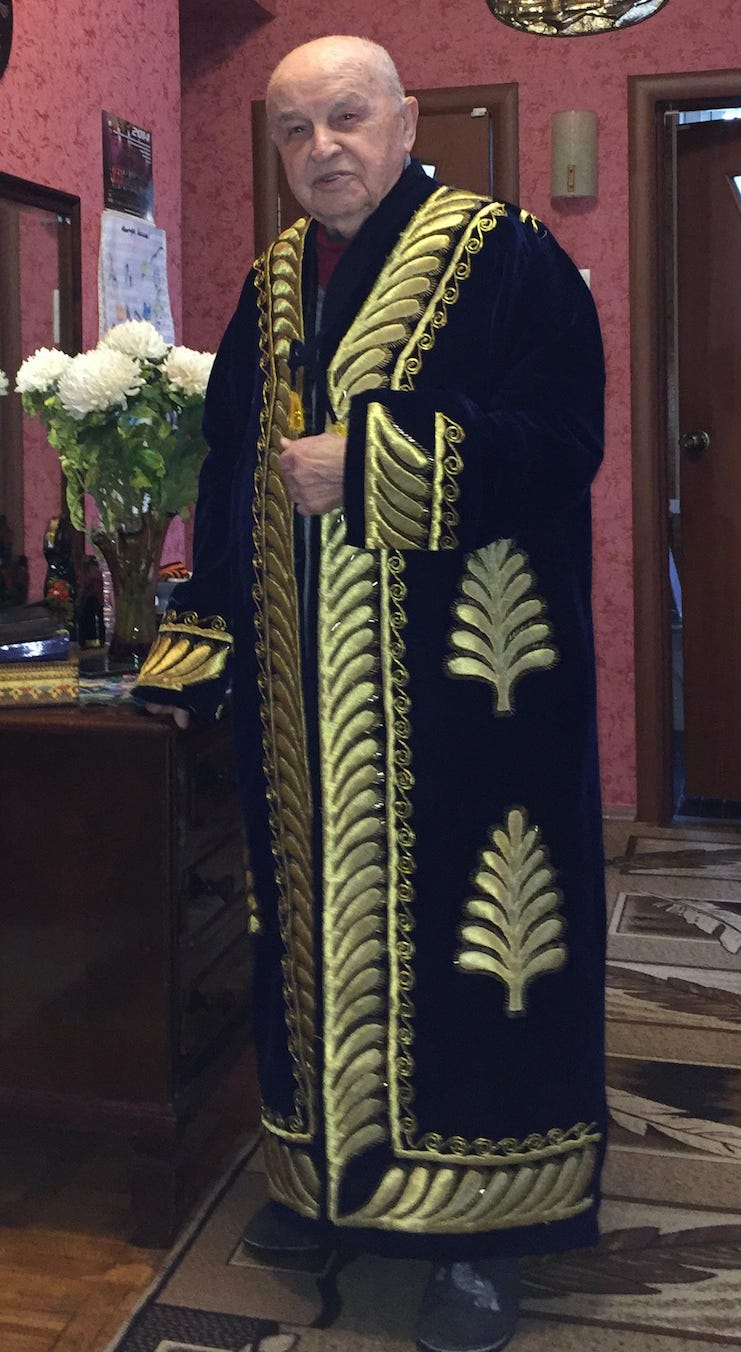
A last photo of Yuri Grigoriev, made available to Microwave News by Oleg Grigorieve, shows him in an embroidered coat, a gift from colleagues in Uzbekistan.
Grigoriev’s Final Work: A Book on the Dangers of 5G
English Translation Available from April 9, 2022
The book, which runs 198 pages with 369 references (many with links), is a free https://www.orsaa.org/uploads/6/7/7/9/67791943/frequencies_used_in_telecommunications__an_integrated_radiobiological_assessment_draft_v3.pdf
Original report by Frances Leader here: https://francesleader.substack.com/p/the-cold-war-of-electro-magnetic

